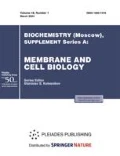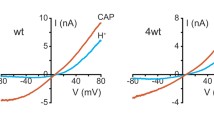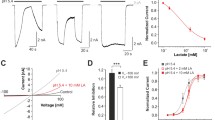Abstract
The transient receptor potential vanilloid type 1 (TRPV1) is a nonselective cation channel gated by numerous chemical and physical stimuli (protons, capsaicin, heat, etc). TRPV1 receptors are important integrators of multiple noxious and inflammatory signals in vertebrates. Modulation of TRPV1 receptors activity is considered to be a promising strategy for pain treatment. SB-366791 is a TRPV1 antagonist that demonstrates good analgesic effects in various models of pain. Molecular mechanisms of the SB-366791 action on TRPV1 are not clear. It antagonizes capsaicin activation in a competitive manner, but the data on its action in the case of activation by protons are controversial. Here we studied effects of SB-366791 when TRPV1 receptors are activated by acidification. We carried out patch-clamp experiments (voltage-clamp mode) on cultured CHO cells stably expressing rat TRPV1 receptors. The whole-cell proton-evoked currents were reduced in the presence of SB-366791. Concentration dependencies of the inhibitory effect of SB-366791 were studied at different pH values. Stronger acidification reduced the maximum effect of SB-366791, while the IC50 values were virtually unaffected. Thus, SB-366791 acts in a non-competitive but pH-dependent way. Probably, there is an allosteric interplay between proton- and capsaicin-binding sites.
Similar content being viewed by others
References
Nilius B., Owsianik G. 2011. The transient receptor potential family of ion channels. Genome Biology. 12 (3), 218.
Holzer P., Iozzo A. 2014. The pharmacology of TRP channels. Br. J. Pharmacol. 171 (10), 2469–2473.
Caterina M.J., Schumacher M.A., Tominaga M., Rosen T.A., Levine J.D., Julius D. 1997. The capsaicin receptor: A heat-activated ion channel in the pain pathway. Nature. 389 (6653), 816–824.
Bevan S., Hothi S., Hughes G., James I.F., Rang H.P., Shah K., Walpole C.S., Yeats J.C. 1992. Capsazepine: A competitive antagonist of the sensory neurone excitant capsaicin. J. Pharmacol. 107 (2), 544–552.
Appendino G., Harrison S., de Petrocellis L., Daddario N., Bianchi F., Schiano Moriello A., Trevisiani M., Benvenuti F., Geppetti P., Di Marzo V. 2003. Halogenation of a capsaicin analogue leads to novel vanilloid TRPV1 receptor antagonists. Br. J. Pharmacol. 139 (8), 1417–1424.
Appendino G., Daddario N., Minassi A., Moriello A.S., de Petrocellis L., Di Marzo V. 2005. The taming of capsaicin. Reversal of the vanilloid activity of N-acylvanillamines by aromatic iodination. J. Med. Chem. 48 (14), 4663–4669.
Appendino G., de Petrocellis L., Trevisiani M., Minassi A., Daddario N., Moriello A.S., Gazzieri D., Ligresti A., Campi B., Fontana G., Pinna C., Geppetti P., Di Marzo V. 2005. Development of the first ultrapotent “capsaicinoid” agonist at transient receptor potential vanilloid type 1 (TRPV1) channels and its therapeutic potential. J. Pharmacol. Exp. Ther. 312 (2), 561–570.
Wahl P., Foged S., Tullin S., Thomsen C. 2001. Iodoresiniferatoxin, a new potent vanilloid receptor antagonist. Mol. Pharmacol. 59 (1), 9–15.
Roberts L.A., Connor M. 2006. TRPV1 antagonists as a potential treatment for hyperalgesia. Recent Pat. CNS Drug Discov. 1 (1), 65–76.
Amann R., Maggi C.A. 1991. Ruthenium red as capsaicin antagonist. Life Sci. 49 (12), 849–856.
Mellor I.R., Ogilvie J., Pluteanu F., Clothier R.H., Parker T.L., Rosini M., Minarini A., Tumiatti V., Melchiorre C. 2004. Methoctramine analogues inhibit responses to capsaicin and protons in rat dorsal root ganglion neurons. Eur. J. Pharmacol. 505 (1–3), 37–50.
Garcia-Martinez C., Humet M., Planells-Cases R., Gomis A., Caprini M., Viana F., De La Pena E., Sanchez-Baeza F., Carbonell T., De Filipe C., Pérez-Paya E., Belmonte C., Messeguer A., Ferrer-Montiel A. 2002. Attenuation of thermal nociception and hyperalgesia by VR1 blockers. Proc. Natl. Acad. Sci. USA. 99 (4), 2374–2379.
Himmel H.M., Kiss T., Borvendeg S.G., Gillen C., Illes P. 2002. The arginine-rich hexapeptide R4W2 is a stereoselective antagonist at the vanilloid receptor 1: A Ca2+ imaging study in adult rat dorsal root ganglion neurons. J. Pharmacol. Exp. Ther. 301 (3), 981–986.
Andreev Y.A., Kozlov S.A., Koshelev S.G., Ivanova E.A., Monastyrnaya M.M., Kozlovskaya E.P., Grishin E.V. 2008. Analgesic compound from sea anemone Heteractis crispa is the first polypeptide inhibitor of vanilloid receptor 1 (TRPV1). J. Biol. Chem. 283 (35), 23914–23921.
Jakab B., Helyes Z., Varga A., Bolcskeyi K., Szabo A., Sandor K., Elekes K., Borzsei R., Keszthelyi D., Pinter E., Petho G., Németh J., Szolcsányi J. 2005. Pharmacological characterization of the TRPV1 receptor antagonist JYL1421 (SC0030) in vitro and in vivo in the rat. Eur. J. Pharmacol. 517 (1–2), 35–44.
Lazar J., Gharat L., Khairathkar-Joshi N., Blumberg P.M., Szallasi A. 2009. Screening TRPV1 antagonists for the treatment of pain: Lessons learned over a decade. Expert Opin. Drug Discov. 4 (2), 159–180.
Wong G.Y., Gavva N.R. 2009. Therapeutic potential of vanilloid receptor TRPV1 agonists and antagonists as analgesics: Recent advances and setbacks. Brain Res. Rev. 60 (1), 262–277.
Garami A., Shimansky Y.P., Pakai E., Oliveira D.L., Gavva N.R., Romanovsky A.A. 2010. Contributions of different modes of TRPV1 activation to TRPV1 antagonist- induced hyperthermia. J. Neurosci. 30 (4), 1435–1440.
Lehto S.G., Tamir R., Deng H., Klionsky L., Kuang R., Le A., Lee D., Louis J.C., Magal E., Manning B.H., Rubino J., Surapaneni S., Tamayo N., Wang T., Wang J., Wang J., Wang W., Youngblood B., Zhang M., Zhu D., Norman M.H., Gavva N.R. 2008. Antihyperalgesic effects of (R,E)-N-(2-hydroxy-2,3-dihydro-1H-acrylamide (AMG8562), a novel transient receptor potential vanilloid type 1 modulator that does not cause hyperthermia in rats. J. Pharmacol. Exp. Ther. 326 (1), 218–229.
Reilly R.M., McDonald H.A., Puttfarcken P.S., Joshi S.K., Lewis L., Pai M., Franklin P.H., Segreti J.A., Neelands T.R., Han P., Chen J., Mantyh P.W., Ghilardi J.R., Turner T.M., Voight E.A., Daanen J.F., Schmidt R.G., Gomtsyan A., Kort M.E., Faltynek C.R., Kym P.R. 2012. Pharmacology of modality-specific transient receptor potential vanilloid-1 antagonists that do not alter body temperature. Exp. Ther. 342 (2), 416–428.
Gunthorpe M.J., Rami H.K., Jerman J.C., Smart D., Gill C.H., Soffin E.M., Luis Hannan S., Lappin S.C., Egerton J., Smith G.D. 2004. Identification and characterisation of SB-366791, a potent and selective vanilloid receptor (VR1/TRPV1) antagonist. Neuropharmacology. 46 (1), 133–149.
Gavva N.R., Tamir R., Qu Y., Klionsky L., Zhang T.G., Immke D., Wang J., Zhu D., Vanderah T.W., Porreca F. 2004. AMG 9810 [(E)-3-(4-t-butylphenyl)-N-(2,3- dihydrobenzo[b][1,4] dioxin-6-yl)acrylamide], a novel vanilloid receptor 1 (TRPV1) antagonist with antihyperalgesic properties. J. Pharmacol. Exp. Ther. 313 (1), 474–484.
Gavva N.R., Tamir R., Klionsky L., Norman M.H., Louis J.-C., Wild K.D., Treanor J.J. 2005. Proton activation does not alter antagonist interaction with the capsaicin-binding pocket of TRPV1. Mol. Pharmacol. 68 (6), 1524–1533.
McIntyre P., McLatchie L.M., Chambers A., Phillips E., Clarke M., Savidge J., Toms C., Peacock M., Shah K., Winter J., Weerasakera N., Webb M., Rang H.P., Bevan S., James I.F. 2001. Pharmacological differences between the human and rat vanilloid receptor 1 (VR1). Br. J. Pharmcol. 132 (5), 1084–1094.
Seabrook G.R., Sutton K.G., Jarolimek W., Hollingworth G.J., Teague S., Webb J., Clark N., Boyce S., Kerby J., Ali Z., Chou M., Middleton R., Kaczorowski G., Jones A.B. 2002. Functional properties of the high-affinity TRPV1 (VR1) vanilloid receptor antagonist (4-hydroxy- 5-iodo-3-methoxyphenylacetate ester) iodo-resiniferatoxin. J. Pharmacol. Exp. Ther. 303 (3), 1052–1060.
Shimizu I., Iida T., Horiuchi N., Caterina M.J. 2005. 5-Iodoresiniferatoxin evokes hypothermia in mice and is a partial transient receptor potential vanilloid 1 agonist in vitro. J. Pharmacol. Exp. Ther. 314 (3), 1378–1385.
Wyllie D.J.A., Chen P.E. 2007. Taking the time to study competitive antagonism. Br. J. Pharmacol. 150, 541–551.
Cao E., Liao M., Cheng Y., Julius D. 2013. TRPV1 structures in distinct conformations reveal mechanisms of activation. Nature. 504 (7478), 113–118.
Author information
Authors and Affiliations
Corresponding author
Additional information
Original Russian Text © M.S. Komarova, N.N. Potapieva, M.V. Nikolaev, 2018, published in Biologicheskie Membrany, 2018, Vol. 35, No. 3, pp. 192–199.
Rights and permissions
About this article
Cite this article
Komarova, M.S., Potapieva, N.N. & Nikolaev, M.V. Non-Competitive but pH-Dependent Action of SB-366791 on Proton-Induced Activation of TRPV1 Receptors. Biochem. Moscow Suppl. Ser. A 12, 107–113 (2018). https://doi.org/10.1134/S1990747818020083
Received:
Accepted:
Published:
Issue Date:
DOI: https://doi.org/10.1134/S1990747818020083




